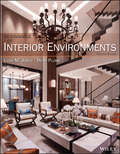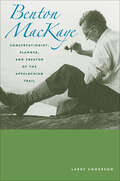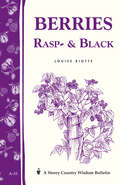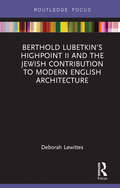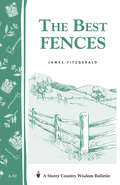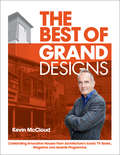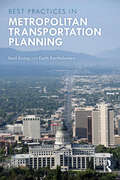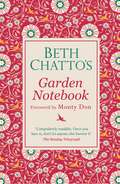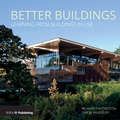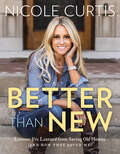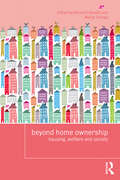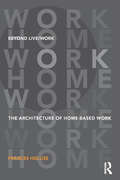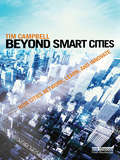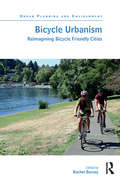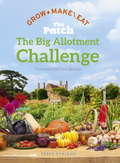- Table View
- List View
Beginnings of Interior Environments (Fashion Ser.)
by Lynn M. Jones Heidi PlumbThe new edition of the leading textbook remains the gold standard for interior design education. In this twelfth edition of Beginnings of Interior Environments, established interior designer and professor Lynn M. Jones, ASID, IDEC collaborates with innovator Heidi Plumb, IIDA, IDEC, to deliver a practical and balanced overview of commercial and residential interior design. Written to offer coverage of the creative and technical characteristics of the profession, the text also addresses Council for Interior Design Accreditation (CIDA) content. Part I opens with a discussion on the scope and value of the profession and includes a pictorial overview of the history of design. Subsequent parts cover design fundamentals, the spatial envelope—including space planning and systems—, products and materiality, and designing for a living. A new chapter addresses the art and science of visual communications. Hundreds of images from actual design projects, supplied by national and international design firms, illustrate quality examples. &“Precedent Studies&” include in-house production work from these practicing designers. Content, updated throughout, includes additional information on design thinking, inclusivity, WELL building standards, casework, and architectural millwork. New end-of-chapter self-directed projects provide students the opportunity to apply their knowledge. Written by two successful educators and practitioners, both NCIDQ certified with terminal degrees, the text applies a balance between education and practice. It is the ideal textbook for introductory interior design or interior architecture courses, and an invaluable resource for anyone looking to apply a holistic interior design perspective to their own home or business. As in previous editions, the text Introduces interior design with a foundation in its health, safety, and welfare benefits Explores design fundamentals, including visual literacy, and the elements and principles of design, with a special emphasis on color and now visual communications Discusses construction, including building components, codes, regulations, as well as lighting, electrical, and communication systems Offers an in-depth examination of the profession, including career pathways and professional organizations Reviews critical global issues such as sustainability, universal design, and culturally sensitive design Includes a dedicated section on interior materials and finishes—floorings, ceilings, wallcoverings, upholstery—and furnishings such as furniture, art, and accessories Leads students to analyze the needs of clients to design safe and sustainable environments that enhance the quality of life Includes a companion site for instructors featuring PowerPoint slides and an Instructor's manual with discussion points, objectives, lecture outlines, learning activities, and example quizzes with answers
Benton MacKaye: Conservationist, Planner, and Creator of the Appalachian Trail (Creating the North American Landscape)
by Larry AndersonPlanner and originator of the Appalachian Trail and a cofounder of the Wilderness Society, Benton MacKaye (1879-1975) was a pioneer in linking the concepts of preservation and recreation. Spanning three-quarters of a century, his long and productive career had a major impact on emerging movements in conservation, environmentalism, and regional planning. MacKaye's seminal ideas on outdoor recreation, wilderness protection, land-use planning, community development, and transportation have inspired generations of activists, professionals, and adventurers seeking to strike a harmonious balance between human need and the natural environment.This pathbreaking biography provides the first complete portrait of this significant and unique figure in American environmental, intellectual, and cultural history. Drawing on extensive research, Larry Anderson traces MacKaye's extensive career, examines his many published works, and describes the importance of MacKaye's relationships with such influential figures as Lewis Mumford, Aldo Leopold, and Walter Lippmann. This book will appeal to students, scholars, and professionals in preservation, conservation, recreation, planning, and American studies, as well as general readers interested in these subjects.
Benton MacKaye: Conservationist, Planner, and Creator of the Appalachian Trail (Creating the North American Landscape)
by Larry AndersonPlanner and originator of the Appalachian Trail and a cofounder of the Wilderness Society, Benton MacKaye (1879-1975) was a pioneer in linking the concepts of preservation and recreation. Spanning three-quarters of a century, his long and productive career had a major impact on emerging movements in conservation, environmentalism, and regional planning. MacKaye's seminal ideas on outdoor recreation, wilderness protection, land-use planning, community development, and transportation have inspired generations of activists, professionals, and adventurers seeking to strike a harmonious balance between human need and the natural environment.This pathbreaking biography provides the first complete portrait of this significant and unique figure in American environmental, intellectual, and cultural history. Drawing on extensive research, Larry Anderson traces MacKaye's extensive career, examines his many published works, and describes the importance of MacKaye's relationships with such influential figures as Lewis Mumford, Aldo Leopold, and Walter Lippmann. This book will appeal to students, scholars, and professionals in preservation, conservation, recreation, planning, and American studies, as well as general readers interested in these subjects.
Berries, Rasp- & Black: Storey Country Wisdom Bulletin A-33 (Storey Country Wisdom Bulletin)
by Louise RiotteSince 1973, Storey's Country Wisdom Bulletins have offered practical, hands-on instructions designed to help readers master dozens of country living skills quickly and easily. There are now more than 170 titles in this series, and their remarkable popularity reflects the common desire of country and city dwellers alike to cultivate personal independence in everyday life.
Berthold Lubetkin’s Highpoint II and the Jewish Contribution to Modern English Architecture
by Deborah LewittesIn 1935, the Russian-born Jewish architect Berthold Lubetkin and his firm Tecton designed Highpoint, a block of flats in London, which Le Corbusier called ‘revolutionary’. Three years later, Lubetkin completed a companion design. Yet Highpoint II felt very different, and the sense that the ideals of modernism had been abandoned seemed hard to dispute. Had modern architecture failed to take root in England? This book challenges the belief that English architecture was on hiatus during the 1930s. Using Highpoint II as a springboard, Deborah Lewittes takes us on a journey through the defining moments of modern English architecture – the ‘high points’ of the period surrounding Highpoint II. Drawing on Lubetkin’s work and his writings, the book argues that he advanced influential, lasting theories which were rooted in his design for Highpoint II. Lubetkin’s work is explored within the context of wider Jewish emigration to London during the interwar years as well as the anti-Semitism that pervaded Britain during the 1930s. As Lewittes demonstrates, this decade was anything but quiet. Providing a new perspective on twentieth-century English architecture, this book is of interest to students and scholars in architectural history, urban studies, Jewish studies, and related fields.
Berthold Lubetkin’s Highpoint II and the Jewish Contribution to Modern English Architecture
by Deborah LewittesIn 1935, the Russian-born Jewish architect Berthold Lubetkin and his firm Tecton designed Highpoint, a block of flats in London, which Le Corbusier called ‘revolutionary’. Three years later, Lubetkin completed a companion design. Yet Highpoint II felt very different, and the sense that the ideals of modernism had been abandoned seemed hard to dispute. Had modern architecture failed to take root in England? This book challenges the belief that English architecture was on hiatus during the 1930s. Using Highpoint II as a springboard, Deborah Lewittes takes us on a journey through the defining moments of modern English architecture – the ‘high points’ of the period surrounding Highpoint II. Drawing on Lubetkin’s work and his writings, the book argues that he advanced influential, lasting theories which were rooted in his design for Highpoint II. Lubetkin’s work is explored within the context of wider Jewish emigration to London during the interwar years as well as the anti-Semitism that pervaded Britain during the 1930s. As Lewittes demonstrates, this decade was anything but quiet. Providing a new perspective on twentieth-century English architecture, this book is of interest to students and scholars in architectural history, urban studies, Jewish studies, and related fields.
Best Development Practices: Doing the Right Thing and Making Money at the Same Time
by Reid EwingThe author draws upon case examples of some of today's most acclaimed developments in this book, and recommends best practice guidelines to help developers create vibrant, livable communities-and still make money. For years, Florida's planners and developers have had to deal with some of the most difficult growth management problems. Now planners and developers across the nation can benefit from the valuable lessons Florida offers on combating urban sprawl. Ewing first searched the state for the best contemporary developments, then distilled their lessons into guidelines for directing new development and assessing the quality of existing development. The 43 practices outlined in this exciting book cover four areas of development-land use, transportation, the environment, and housing. They apply to a broad range of development projects, including small planned communities, residential subdivisions, and commercial centers. The book's recommendations are based upon the experiences of successful developers and supported by empirical research. The proof lies in the compelling real-world examples Ewing highlights throughout the text. Illustrated with dozens of photographs and written in a lively style, this book is must reading for all those seeking better ways to plan and design communities. Developers will find proven, feasible land development regulations and benchmarks against which to evaluate development proposals.
Best Development Practices: Doing the Right Thing and Making Money at the Same Time
by Reid EwingThe author draws upon case examples of some of today's most acclaimed developments in this book, and recommends best practice guidelines to help developers create vibrant, livable communities-and still make money. For years, Florida's planners and developers have had to deal with some of the most difficult growth management problems. Now planners and developers across the nation can benefit from the valuable lessons Florida offers on combating urban sprawl. Ewing first searched the state for the best contemporary developments, then distilled their lessons into guidelines for directing new development and assessing the quality of existing development. The 43 practices outlined in this exciting book cover four areas of development-land use, transportation, the environment, and housing. They apply to a broad range of development projects, including small planned communities, residential subdivisions, and commercial centers. The book's recommendations are based upon the experiences of successful developers and supported by empirical research. The proof lies in the compelling real-world examples Ewing highlights throughout the text. Illustrated with dozens of photographs and written in a lively style, this book is must reading for all those seeking better ways to plan and design communities. Developers will find proven, feasible land development regulations and benchmarks against which to evaluate development proposals.
The Best Fences: Storey's Country Wisdom Bulletin A-92 (Storey Country Wisdom Bulletin)
by James FitzgeraldSince 1973, Storey's Country Wisdom Bulletins have offered practical, hands-on instructions designed to help readers master dozens of country living skills quickly and easily. There are now more than 170 titles in this series, and their remarkable popularity reflects the common desire of country and city dwellers alike to cultivate personal independence in everyday life.
The Best of Grand Designs
by Kevin McCloudA complete celebration of Britain’s favourite architectural show.
Best Practices in Metropolitan Transportation Planning: New Advances, Approaches, And Best Practices
by Reid Ewing Keith BartholomewPlanning at a metropolitan scale is important for effective management of urban growth, transportation systems, air quality, and watershed and green-spaces. It is fundamental to efforts to promote social justice and equity. Best Practices in Metropolitan Transportation Planning shows how the most innovative metropolitan planning organizations (MPOs) in the United States are addressing these issues using their mandates to improve transportation networks while pursuing emerging sustainability goals at the same time. As both a policy analysis and a practical how-to guide, this book presents cutting-edge original research on the role accessibility plays - and should play - in transportation planning, tracks how existing plans have sought to balance competing priorities using scenario planning and other strategies, assesses the results of various efforts to reduce automobile dependence in cities, and explains how to make planning documents more powerful and effective. In highlighting the most innovative practices implemented by MPOs, regional planning councils, city and county planning departments and state departments of transportation, this book aims to influence other planning organizations, as well as influence federal and state policy discussions and legislation.
Best Practices in Metropolitan Transportation Planning: New Advances, Approaches, And Best Practices
by Reid Ewing Keith BartholomewPlanning at a metropolitan scale is important for effective management of urban growth, transportation systems, air quality, and watershed and green-spaces. It is fundamental to efforts to promote social justice and equity. Best Practices in Metropolitan Transportation Planning shows how the most innovative metropolitan planning organizations (MPOs) in the United States are addressing these issues using their mandates to improve transportation networks while pursuing emerging sustainability goals at the same time. As both a policy analysis and a practical how-to guide, this book presents cutting-edge original research on the role accessibility plays - and should play - in transportation planning, tracks how existing plans have sought to balance competing priorities using scenario planning and other strategies, assesses the results of various efforts to reduce automobile dependence in cities, and explains how to make planning documents more powerful and effective. In highlighting the most innovative practices implemented by MPOs, regional planning councils, city and county planning departments and state departments of transportation, this book aims to influence other planning organizations, as well as influence federal and state policy discussions and legislation.
Beth Chatto's Garden Notebook
by Beth Chatto'I return to Beth Chatto's books constantly. For those who are new to her work, you are entering into a life-long relationship with a wise friend and gardener' Monty Don'Compulsively readable. Once you have it, don't let anyone else borrow it' SUNDAY TELEGRAPHSharing the hopes and successes - and sometimes failures - of her work, Beth Chatto reveals what is really involved in maintaining a unique and flourishing garden. Written from notes that she kept regularly, this engaging book offers help on a whole range of topics. There is guidance on designing, planting and grouping. She describes methods of propagation, shows how plants can be helped to maturity, and gives advice on managing a garden and its plants and on performing all the day-to-day tasks involved.
Better Buildings: Learning from Buildings in Use
by Richard Partington Simon BradburyThis book started life as a successor to Sustainable Architecture, published in 2007, which set out to prove that sustainable architecture can indeed both ‘lift the spirit’ as well as save the planet. This fully revised edition seeks to take a step further, exploring how sustainable buildings are occupied and work, and sheds light on the methods used to observe this. Through short essays from thought-leaders and case studies of visually stunning, environmentally ground-breaking projects, Better Buildings provides architects with the inspiration and tools they need to deliver sustainable design.
Better Buildings: Learning from Buildings in Use
by Richard Partington Simon BradburyThis book started life as a successor to Sustainable Architecture, published in 2007, which set out to prove that sustainable architecture can indeed both ‘lift the spirit’ as well as save the planet. This fully revised edition seeks to take a step further, exploring how sustainable buildings are occupied and work, and sheds light on the methods used to observe this. Through short essays from thought-leaders and case studies of visually stunning, environmentally ground-breaking projects, Better Buildings provides architects with the inspiration and tools they need to deliver sustainable design.
Better Than New: Lessons I've Learned from Saving Old Homes (and How They Saved Me)
by Nicole CurtisA New York Times and USA Today Bestseller For the first time, Nicole Curtis, the star of the megahit HGTV and DIY Network show Rehab Addict, reveals her private struggles, her personal victories, and the inspiring lessons we can all learn from them. Nicole Curtis is the tough, soulful, charismatic dynamo who for the past twenty years has worked tirelessly to restore historical houses, often revitalizing neighborhoods in the process. And also, in the process, drawing millions of fans to her television show, Rehab Addict, where they follow each step of the hard work and singular vision that transform the seemingly lost cause of a run-down building into a beautifully restored home. But there is so much more to this self-taught expert and working mom. With hersignature irresistible honesty and energy, Curtis writes about a project that every reader will find compelling: how she rehabbed herself. Better Than New reveals what&’s not seen on TV—Curtis&’s personal battles and her personal triumphs, her complicated relationships, her life as a single mother, the story of how she got started remodeling houses, and the consuming ins and outs of producing a megahit television show while keeping up with two kids, two rescue dogs, and countless tasks on her home renovation punch lists. Followers of the show will get an inside look at some of her most famous restorations, including the Dollar house, the Minnehaha house, the Campbell Street project, and the Ransom Gillis mansion. Part inspirational memoir and part self-help guide, Better Than New is a journey ineight chapters—each pinned to the story of a house that Curtis has remodeled, each delivering a hard-fought lesson about life—that takes readers to the place we all want to be: home.
Beyond Home Ownership: Housing, Welfare and Society (Housing and Society Series)
by Richard Ronald Marja ElsingaIn context of ongoing transformations in housing markets and socioeconomic conditions, this book focuses on past, current and future roles of home ownership in social policies and welfare practices. It considers owner-occupied housing in terms of diverse meanings and manifestations, but in particular the part played by housing tenure in the political, socioeconomic and demographic changes that have characterized the pre- and post-crisis era. The intensified promotion of home ownership in recent decades helped stimulate an increasing orientation towards the private consumption of housing, not only as a home, but also an asset – or possibly speculative vehicle – that enhances household economic capacity and can be transferred to children or other family, or even exchanged for other goods. The latest global financial crisis, however, made it clear that owner-occupied housing markets and mortgage sectors have become deeply embedded in networks of socioeconomic interdependency and risk. This collection engages with numerous debates on housing and society in a range of developed societies from North America to Asia-Pacific to North, South, East and West Europe. Interdisciplinary contributors draw upon diverse empirical data to explore how housing and home ownership has become so embedded in polity, economy and household welfare conditions in various social and cultural contexts. Another concern is what lies beyond home ownership considering the integration of housing systems with economic growth and social stability appears to be unravelling. This volume speaks to public debates concerning the future of housing markets, policy and tenure, providing deep and provocative insights for academics, students and professionals alike.
Beyond Home Ownership: Housing, Welfare and Society (Housing and Society Series)
by Richard Ronald Marja ElsingaIn context of ongoing transformations in housing markets and socioeconomic conditions, this book focuses on past, current and future roles of home ownership in social policies and welfare practices. It considers owner-occupied housing in terms of diverse meanings and manifestations, but in particular the part played by housing tenure in the political, socioeconomic and demographic changes that have characterized the pre- and post-crisis era. The intensified promotion of home ownership in recent decades helped stimulate an increasing orientation towards the private consumption of housing, not only as a home, but also an asset – or possibly speculative vehicle – that enhances household economic capacity and can be transferred to children or other family, or even exchanged for other goods. The latest global financial crisis, however, made it clear that owner-occupied housing markets and mortgage sectors have become deeply embedded in networks of socioeconomic interdependency and risk. This collection engages with numerous debates on housing and society in a range of developed societies from North America to Asia-Pacific to North, South, East and West Europe. Interdisciplinary contributors draw upon diverse empirical data to explore how housing and home ownership has become so embedded in polity, economy and household welfare conditions in various social and cultural contexts. Another concern is what lies beyond home ownership considering the integration of housing systems with economic growth and social stability appears to be unravelling. This volume speaks to public debates concerning the future of housing markets, policy and tenure, providing deep and provocative insights for academics, students and professionals alike.
Beyond Live/Work: The Architecture of Home-based Work
by Frances HollissBeyond Live/Work: the architecture of home-based work explores the old but neglected building type that combines dwelling and workplace, the ‘workhome’. It traces a previously untold architectural history illustrated by images of largely forgotten buildings. Despite having existed for hundreds, if not thousands, of years in every country across the globe this dual-use building type has long gone unnoticed. This book analyses the lives and premises of 90 contemporary UK and US home-based workers from across the social spectrum and in diverse occupations. It generates a series of typologies and design considerations for the workhome that will be useful for design professionals, students, policy-makers and home-based workers themselves. In the context of a globalising economy, more women in work than ever before and enabling new technologies, the home-based workforce is growing rapidly. Demonstrating how this can be a socially, economically and environmentally sustainable working practice, this book presents the workhome as the house of the future.
Beyond Live/Work: The Architecture of Home-based Work
by Frances HollissBeyond Live/Work: the architecture of home-based work explores the old but neglected building type that combines dwelling and workplace, the ‘workhome’. It traces a previously untold architectural history illustrated by images of largely forgotten buildings. Despite having existed for hundreds, if not thousands, of years in every country across the globe this dual-use building type has long gone unnoticed. This book analyses the lives and premises of 90 contemporary UK and US home-based workers from across the social spectrum and in diverse occupations. It generates a series of typologies and design considerations for the workhome that will be useful for design professionals, students, policy-makers and home-based workers themselves. In the context of a globalising economy, more women in work than ever before and enabling new technologies, the home-based workforce is growing rapidly. Demonstrating how this can be a socially, economically and environmentally sustainable working practice, this book presents the workhome as the house of the future.
Beyond Smart Cities: How Cities Network, Learn and Innovate
by Tim CampbellThe promise of competitiveness and economic growth in so-called smart cities is widely advertised in Europe and the US. The promise is focussed on global talent and knowledge economies and not on learning and innovation. But to really achieve smart cities – that is to create the conditions of continuous learning and innovation – this book argues that there is a need to understand what is below the surface and to examine the mechanisms which affect the way cities learn and then connect together. This book draws on quantitative and qualitative data with concrete case studies to show how networks already operating in cities are used to foster and strengthen connections in order to achieve breakthroughs in learning and innovation. Going beyond smart cities means understanding how cities construct, convert and manipulate relationships that grow in urban environments. Cities discussed in this book – Amman, Barcelona, Bilbao, Charlotte,Curitiba, Juarez, Portland, Seattle and Turin – illuminate a blind spot in the literature. Each of these cities has achieved important transformations, and learning has played a key role, one that has been largely ignored in academic circles and practice concerning competitiveness and innovation.
Beyond Smart Cities: How Cities Network, Learn and Innovate
by Tim CampbellThe promise of competitiveness and economic growth in so-called smart cities is widely advertised in Europe and the US. The promise is focussed on global talent and knowledge economies and not on learning and innovation. But to really achieve smart cities – that is to create the conditions of continuous learning and innovation – this book argues that there is a need to understand what is below the surface and to examine the mechanisms which affect the way cities learn and then connect together. This book draws on quantitative and qualitative data with concrete case studies to show how networks already operating in cities are used to foster and strengthen connections in order to achieve breakthroughs in learning and innovation. Going beyond smart cities means understanding how cities construct, convert and manipulate relationships that grow in urban environments. Cities discussed in this book – Amman, Barcelona, Bilbao, Charlotte,Curitiba, Juarez, Portland, Seattle and Turin – illuminate a blind spot in the literature. Each of these cities has achieved important transformations, and learning has played a key role, one that has been largely ignored in academic circles and practice concerning competitiveness and innovation.
Bicycle Urbanism: Reimagining Bicycle Friendly Cities (Urban Planning and Environment)
by Rachel BerneyOver recent decades, bicycling has received renewed interest as a means of improving transportation through crowded cities, improving personal health, and reducing environmental impacts associated with travel. Much of the discussion surrounding cycling has focused on bicycle facility design—how to best repurpose road infrastructure to accommodate bicycling. While part of the discussion has touched on culture, such as how to make bicycling a larger part of daily life, city design and planning have been sorely missing from consideration. Whilst interdisciplinary in its scope, this book takes a primarily planning approach to examining active transportation, and especially bicycling, in urban areas. The volume examines the land use aspects of the city—not just the streetscape. Illustrated using a range of case studies from the USA, Canada, and Australia, the volume provides a comprehensive overview of key topics of concern around cycling in the city including: imagining the future of bicycle-friendly cities; integrating bicycling into urban planning and design; the effects of bike use on health and environment; policies for developing bicycle infrastructure and programs; best practices in bicycle facility design and implementation; advances in technology, and economic contributions.
Bicycle Urbanism: Reimagining Bicycle Friendly Cities (Urban Planning and Environment)
by Rachel BerneyOver recent decades, bicycling has received renewed interest as a means of improving transportation through crowded cities, improving personal health, and reducing environmental impacts associated with travel. Much of the discussion surrounding cycling has focused on bicycle facility design—how to best repurpose road infrastructure to accommodate bicycling. While part of the discussion has touched on culture, such as how to make bicycling a larger part of daily life, city design and planning have been sorely missing from consideration. Whilst interdisciplinary in its scope, this book takes a primarily planning approach to examining active transportation, and especially bicycling, in urban areas. The volume examines the land use aspects of the city—not just the streetscape. Illustrated using a range of case studies from the USA, Canada, and Australia, the volume provides a comprehensive overview of key topics of concern around cycling in the city including: imagining the future of bicycle-friendly cities; integrating bicycling into urban planning and design; the effects of bike use on health and environment; policies for developing bicycle infrastructure and programs; best practices in bicycle facility design and implementation; advances in technology, and economic contributions.
The Big Allotment Challenge: The Big Allotment Challenge
by Tessa EveleghGrowing your own fruit and vegetables is surprisingly easy whatever the size of your garden or allotment. You don't need to be entirely self-sufficient but there's nothing more satisfying than being able to harvest your own tomatoes snip a few leaves from a salad bed or make strawberry jam from home-grown strawberries. And by planting some easy-to-grow flowering plants it's perfectly possible to have freshly picked cut flowers to decorate your table.Accompanying the BBC2 series Grow Make Eat celebrates our burgeoning interest in knowing where our food comes from and is a practical guide to making your garden a haven of productivity. With essential know-how on everything from soil and compost to pruning and pests the book is aimed at novice gardens. There's an A-Z section on easy-to-grow vegetables fruit herbs and cut flowers; foolproof recipes for transforming your produce into delicious jams jellies chutneys and cordials; and stunningly simple flower arrangements.
